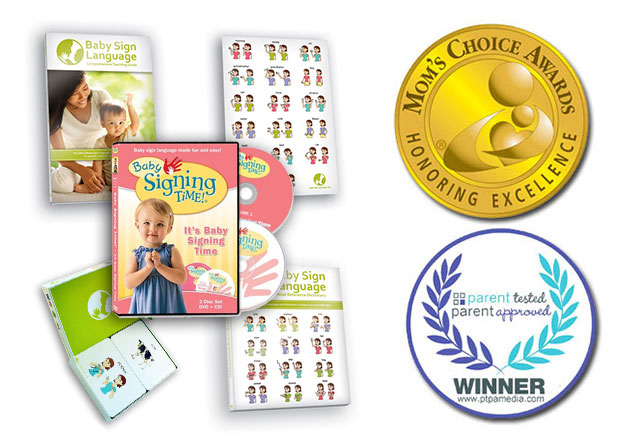Step Four:
Expand Your Baby’s Signing Vocabulary
Expand your baby’s vocabulary, adding more signs after your child masters the basic set. Here’s how:
- Follow Their Interests – Teaching naturally motivated signs
- Extending Along Themes – Add connected signs
- Teaching Aids – Use flash cards and other aids to expand signing
1. Introduction
Once baby learns his or her first few signs, start adding a few more signs, and then when those are learned, add a few more. The first ten or so signs will come very gradually, but the rate of learning will accelerate after the first few months. Baby will soon become more proficient at signing and will even start prompting you for new signs.
Follow your child’s interests when adding new signs, taking advantage of their natural curiosity about their world.
Adding signs gradually makes it easier for baby to learn. And while we add new signs, we still want to keep giving the old signs a workout to keep baby from forgetting those old signs.
2. Follow Their Interests
Observe what kinds of signs are most interesting to baby, and focus most of your vocabulary expansion on these topics. For example, if your baby is fascinated by food signs, make most of your new signs about types of food.
Particularly at this early stage, it is much more important to get momentum and keep it fun than it is to learn any particular signs. Just like when a child is learning to read, you just want them to read, and shouldn’t be too concerned about what they are reading. There will be plenty of time later to balance out their vocabulary and start following their interests.
3. Extending Along Themes
It is easiest to teach new signs in groups of related concepts. For example animals, foods, vehicles, people, colors, etc. Selecting a theme that interests your child, and then add new signs to that group. The contrast between the items in the group help baby understand the meaning of the word. For example, teaching hot and cold together is easier than teaching the signs separately because the meanings of the two words are related and understanding one illuminates the other.
Numbers and letters are also good themes, but are too abstract for the early stages of baby sign language and should be saved for more advanced toddlers.
4. Teaching Aids
Once baby gets more advanced, you will start learning words that you don’t have a lot of exposure to in real life. To facilitate the learning of these words, you can start using teaching aids to help you.
- Flash Cards – print out some of our baby sign language flash cards to add groups of signs, such as animals or colors.
- Picture Books – sign along to your baby’s favorite board books. Very simple books where each page has a clear theme that can be signed are best. For example Eric Carle’s Brown Bear has one animal on each page of the book.
- Props – figurines are another great way to teach signs. Figurines representing different animals, vehicles, or people are common choices. For small children, select figurines that are small enough for them to hold, but big enough so that they are not at risk of being swallowed.
Start Signing with the Baby Sign Language Kit
Our award-winning Baby Sign Language Kit gets your baby signing faster.
- DVDs – baby learns to sign while being entertained by the music of Rachel Coleman & the Signing Time Crew
- Flash Cards – extend baby’s vocabulary to topics like household items and animals with these sturdy flash cards
- Teaching Guide – covers advanced topics for faster results, potty training, and transitioning to speech
- Signing Dictionary – always have the right sign at your fingertips to satisfy your child’s curiosity
- Wall Chart – help grandparents, babysitters, and caregivers understand the basic signs






